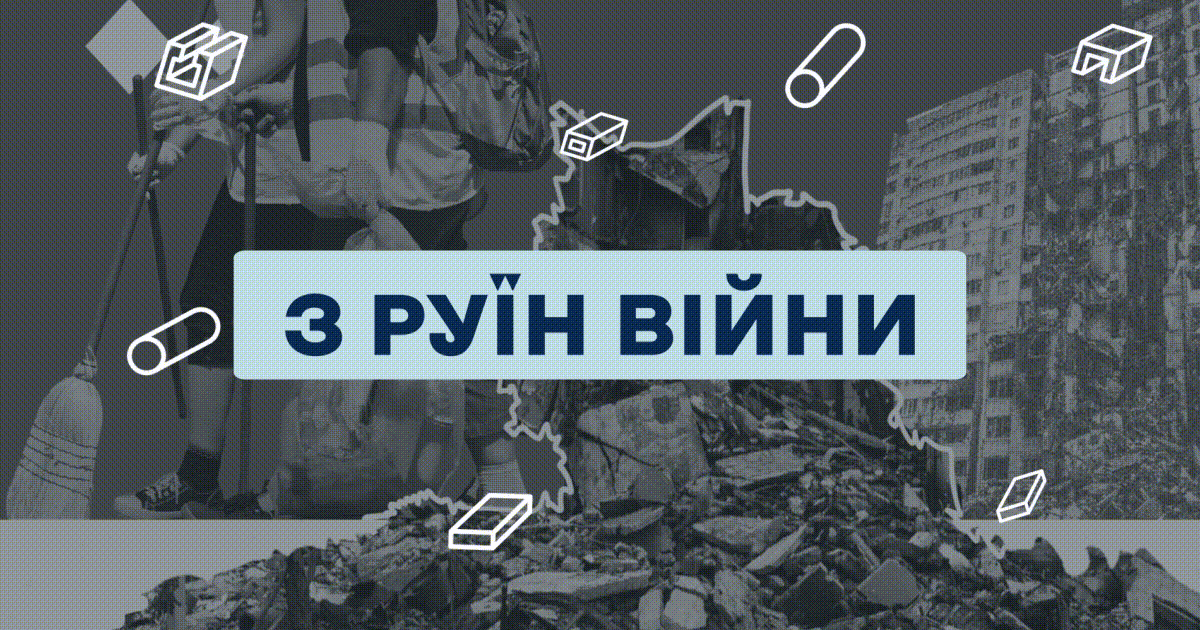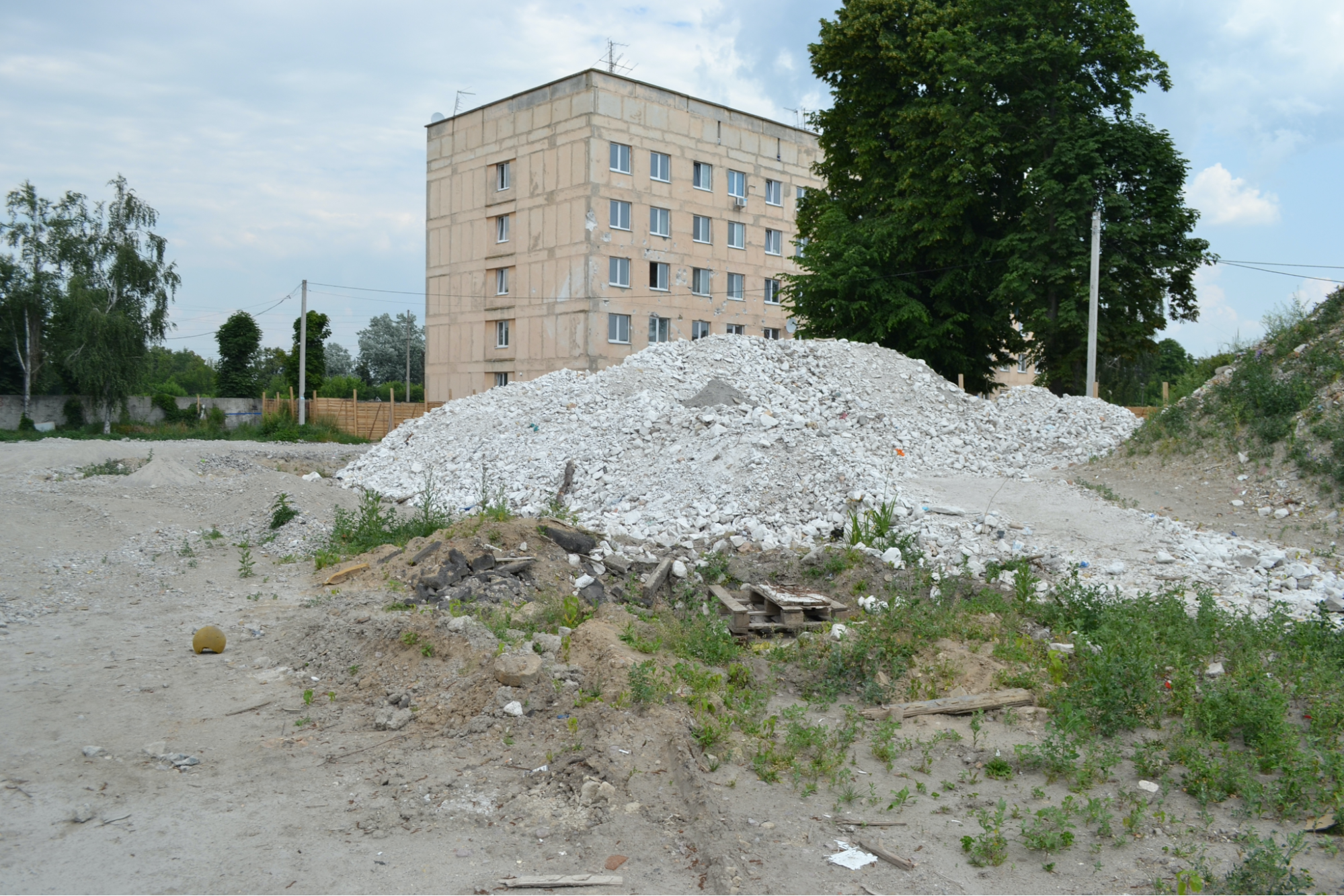Rubryka learned with the help of specialists of the U-LEAD with Europe Program How local communities can properly organize the removal of debris after enemy strikes and the dismantling of damaged or destroyed buildings, how and where to store waste from destruction, and how to keep records of such waste.


As of February 2023, the amount of destruction waste in Ukraine due to the military aggression of the Russian Federation has already amounted to about 10 to 12 million tons, and this number is growing. In particular, as of the beginning of July 2023, the amount of waste from destroyed Russian equipment amounted to 527,000 tons.
Waste from demolitions must be collected so as not to harm the environment or minimize this impact. In particular, part of this waste can be immediately sorted and sent for processing. But, since a certain volume of these wastes can be dangerous, it must be done following the rules recorded in various regulatory documents.
To simplify the search for the necessary information by the owners of destroyed and damaged objects and those responsible for handling such waste, the U-LEAD with Europe Program experts have compiled an algorithm for handling waste from destruction.


The village of Hostomel near Kyiv suffered 40% destruction due to Russia's aggression: 4,553 buildings out of 11,874 were damaged to varying degrees, and 905 of them were completely destroyed or severely damaged. Accordingly, the amount of waste from the destruction was massive.
Photo: After the liberation of Hostomel, there were spontaneous landfills of household garbage and waste from the destruction / Photo provided by Tetyana Bilan
"There was waste all over the Hostomel community: household and construction," says Tetyana Bilan, then head of the utility company Hostomel Housing and Communal Administration (HHCA). "We had a contract for the removal of household waste to the Borodyanka landfill, and at first, we probably took three to four cars of construction waste to ECO.SERVICE LLC, and then we realized it would be too expensive. I started looking for sites for such garbage."
Photo: There were such landfills throughout the community / Photo courtesy of Tetyana Bilan
Photo: Employees of the utility company Hostomel Housing and Communal Administration sort garbage / Photo: Tetyana Bilan
The solution was mutually beneficial for the owners of land plots, which had many pits and ravines. "We concluded contracts with the owners of such land plots for the free removal of this construction waste. It went to the people as a soil sprinkle," explains Bilan.
Photo: Employees of the Hostomel Housing and Communal Administration clean up a spontaneous landfill / Photo provided by Tetyana Bilan
How was it organized? Volunteers who were in Hostomel at that time took the waste from the destruction to one designated place. The employees of the Hostomel Housing and Communal Administration — there were 12 of them immediately after the liberation of the Kyiv region, and later, 20 sorted this waste: construction waste and household waste — separately.
Photo: Employees of the utility company Hostomel Housing and Communal Administration sort garbage / Photo: Tetyana Bilan
The Hostomel community had to pay only for the fuel and lubricants used on the road, and the service itself was free of charge.
Photo: Employees of the utility company Hostomel Housing and Communal Administration pick up garbage / Photo: Tetyana Bilan
"I suggested to the management that they also install a crusher so that it would be possible to grind that garbage and fill in the damaged streets. 75 kW of electricity was needed for it to start. Apparently, similar equipment is currently being used by a French company that is renovating part of residential buildings in Hostomel," says Bilan. By the way, Rubryka reported about this reconstruction experience using waste from the destruction.
Unfortunately, Bilan did not find agreement with the management, her contract was not renewed, and the waste from the destruction is now being removed from the community under multi-million contracts. Bilan currently works as the head of the housing and communal services department of Buchaservice communal enterprise. In the Buchanska community, which was also badly affected by the actions of the occupiers, the removal of waste from the destruction is well established, says Bilan. Residents of the community also receive help with this. After all, a certain part of the people did not return to Bucha immediately after the liberation, and sometimes, people are still sorting through the rubble in their yards.
At the same time, as a resident of the no less mutilated Moschun, Bilan complains that no such works are currently being carried out in the village. "The village was on the first line of defense, but now it seems that everyone has forgotten about it," Bilan complains.
What do regulatory documents say about the procedure for handling such waste? Who is responsible for this?
The following government documents regulate the management of demolition waste in Ukraine:
Waste generated:
The main components of such waste. Infographics by Rubryka
The main components of such waste are parts of building structures, fillings of door and window blocks, engineering networks, and sanitary and technical devices.
Associated components of waste from destruction are equipment, personal belongings, furniture, household appliances, and organic substances, that is, what was inside or next to the object at the time of the strike.
There are two possible answers here. The first is the owner or manager of the damaged object or the owner or user of the land plot within which the waste from the destruction is placed. The second is an authorized body. These can be:
The authorized body is responsible for waste from destruction placed on streets and roads, in parks, squares, embankments, residential areas, beaches, cemeteries (including if this waste got into these areas due to the impact of a shock wave), and in other public places. Infographics by Rubryka
In addition, it is the authorized body that must take care of the waste in other places — if it is not possible to establish the owner of the waste.
If the owner of the site with demolition waste cannot handle the waste for technical or economic reasons, they can also apply to the relevant authority. By the way, this body should, if possible, collect, pre-sort, and separate hazardous waste.
First of all — and this is the very first rule — you can perform any work only if there is no threat of an emergency collapse of the object as a whole or its parts. If there is no such threat, then the authorized body in the community should organize and coordinate some measures.
First of all, the authorized body organizes and coordinates preparatory measures. Among them are:
Infographics by Rubryka
Next, the authorized body organizes and coordinates the clearing of the territory. That is, it collects waste from demolitions, sorts or separately collects waste immediately on site (if possible), and transports waste to waste management facilities or temporary storage sites.
First of all, it is necessary to clean up the following sites in the community:
1) streets and roads of settlements;
2) territories adjacent to social infrastructure facilities, administrative buildings, and buildings of fire and rescue units and emergency and rescue services;
3) residential areas of apartment buildings, dormitories.
Infographics by Rubryka
На території, що зазнала руйнувань, треба
In the territory that was destroyed, it is necessary to
When planning the dismantling of the object, the community should strive to:
During disassembly:
Infographics by Rubryka
Work should be stopped immediately if found:
Territorial bodies of the State Emergency Service and law enforcement agencies must be immediately informed.
Kyiv military (Kyiv city) and regional military (state) administrations make decisions on creating sites for temporary storage of such waste.
The territory for the temporary storage of demolition waste must have areas for:
Infographics by Rubryka
The territory for the temporary storage of waste from the destruction must be placed by:
The site where the demolition waste will be stored must have a solid and level base or cover. It can be concrete, asphalt, or compacted soil covered with a layer of geomembrane at least 1.5 millimeters thick, protected from mechanical damage by a layer at least 0.5 meters thick.
At the same time, waste storage must have an entrance and access roads that ensure the unhindered passage of vehicles. In addition, free passage for fire and other special equipment must be ensured (if combustible waste is stored there).
In addition, the calculated volume of water for external fire extinguishing should be provided in such a place (if combustible waste is stored here).
If necessary, you should arrange:
1) Waste from destruction is stored here during the period of martial law and one year from the date of termination or cancellation of martial law.
2) Only the main components of demolition waste that do not contain and/or are not contaminated with hazardous waste are processed here.
How exactly are the main components of demolition waste processed:
1) separate waste components,
2) crush them,
3) fractionate.
It is prohibited to:
The authorized body collects information from the territories affected by destruction, places of temporary storage of waste from destruction, and objects of waste management from destruction and publishes it on its official website.
The authorized body submits collected information on the identification and accounting of demolition waste to the Kyiv military (Kyiv city) or regional military (state) administrations no later than the 5th of each month.
For their part, the specified administrations submit summarized information on waste from destruction every month no later than the 10th of the month to the Ministry of Reconstruction.
Unfortunately, Ukrainian communities are destroyed every day by Russian attacks. Dealing with waste from these destructions is a new daily challenge for many. That is why it is important to remember all these rules and apply them in practice — because waste management also affects the future of the community, its safety, and the health of its residents.
Photos used: Mykola Tymchenko, Rubryka, Depositphotos
This article was published as part of the Voice of Communities campaign, which is part of the Program for Ukraine on local empowerment, accountability, and development U-LEAD with Europe, jointly funded by the EU and its member states Germany, Poland, Sweden, Denmark, Estonia, and Slovenia to support Ukraine on its way to strengthening local self-government. U-LEAD promotes transparent, accountable, and multi-level governance in Ukraine that responds to the needs of citizens and empowers communities.
39 років тому аварія на Чорнобильській АЕС призвела до відселення людей із територій, забруднених радіоактивними… Читати більше
Recovery Camp is a psychosocial rehabilitation project for Ukrainian children that has been running for… Читати більше
Екологічна освіта, громадянська наука та цікава практика — складники ініціативи, яку втілили для молоді Краснокутської… Читати більше
A team of researchers has trained an AI model to see not just rubble in… Читати більше
У лікарнях Харкова та Ужгорода студенти під наставництвом психологинь, менторів та супервізора проводять для дітей… Читати більше
У Лубнах фахівці, які допомагають військовим, вчилися будувати довірливий контакт із тваринами, зокрема кіньми та… Читати більше
Цей сайт використовує Cookies.